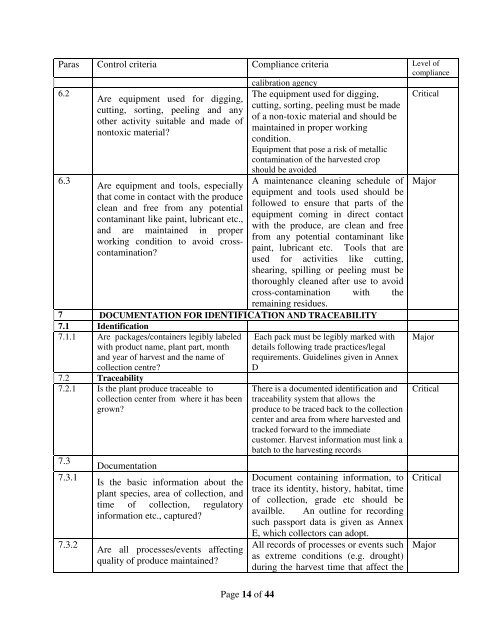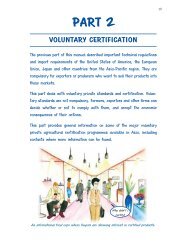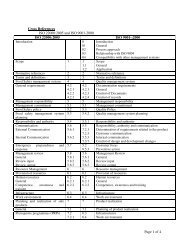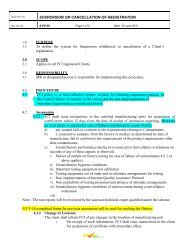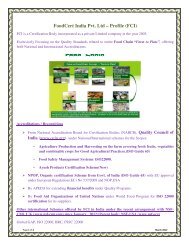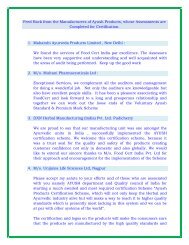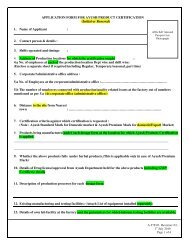Standard for Good Field Collection Practices - NMPB
Standard for Good Field Collection Practices - NMPB
Standard for Good Field Collection Practices - NMPB
Create successful ePaper yourself
Turn your PDF publications into a flip-book with our unique Google optimized e-Paper software.
Paras Control criteria Compliance criteria Level of<br />
compliance<br />
calibration agency<br />
6.2<br />
6.3<br />
Are equipment used <strong>for</strong> digging,<br />
cutting, sorting, peeling and any<br />
other activity suitable and made of<br />
nontoxic material?<br />
Are equipment and tools, especially<br />
that come in contact with the produce<br />
clean and free from any potential<br />
contaminant like paint, lubricant etc.,<br />
and are maintained in proper<br />
working condition to avoid crosscontamination?<br />
The equipment used <strong>for</strong> digging,<br />
cutting, sorting, peeling must be made<br />
of a non-toxic material and should be<br />
maintained in proper working<br />
condition.<br />
Equipment that pose a risk of metallic<br />
contamination of the harvested crop<br />
should be avoided<br />
A maintenance cleaning schedule of<br />
equipment and tools used should be<br />
followed to ensure that parts of the<br />
equipment coming in direct contact<br />
with the produce, are clean and free<br />
from any potential contaminant like<br />
paint, lubricant etc. Tools that are<br />
used <strong>for</strong> activities like cutting,<br />
shearing, spilling or peeling must be<br />
thoroughly cleaned after use to avoid<br />
cross-contamination with the<br />
remaining residues.<br />
7 DOCUMENTATION FOR IDENTIFICATION AND TRACEABILITY<br />
7.1 Identification<br />
7.1.1 Are packages/containers legibly labeled<br />
with product name, plant part, month<br />
and year of harvest and the name of<br />
collection centre?<br />
Each pack must be legibly marked with<br />
details following trade practices/legal<br />
requirements. Guidelines given in Annex<br />
D<br />
7.2 Traceability<br />
7.2.1 Is the plant produce traceable to<br />
collection center from where it has been<br />
grown?<br />
7.3<br />
7.3.1<br />
7.3.2<br />
Documentation<br />
Is the basic in<strong>for</strong>mation about the<br />
plant species, area of collection, and<br />
time of collection, regulatory<br />
in<strong>for</strong>mation etc., captured?<br />
Are all processes/events affecting<br />
quality of produce maintained?<br />
There is a documented identification and<br />
traceability system that allows the<br />
produce to be traced back to the collection<br />
center and area from where harvested and<br />
tracked <strong>for</strong>ward to the immediate<br />
customer. Harvest in<strong>for</strong>mation must link a<br />
batch to the harvesting records<br />
Document containing in<strong>for</strong>mation, to<br />
trace its identity, history, habitat, time<br />
of collection, grade etc should be<br />
availble. An outline <strong>for</strong> recording<br />
such passport data is given as Annex<br />
E, which collectors can adopt.<br />
All records of processes or events such<br />
as extreme conditions (e.g. drought)<br />
during the harvest time that affect the<br />
Critical<br />
Major<br />
Major<br />
Critical<br />
Critical<br />
Major<br />
Page 14 of 44


